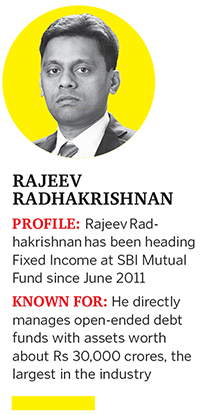
Rajeev Radhakrishnan: Inflation And Fiscal Deficit Will Determine Interest Rates
The trajectory of consumer price inflation and fiscal deficit numbers impacting the demand-supply equation for G-secs would be key determinants of rates over the coming year
External sector pressures and the subsequent Reserve Bank of India (RBI) focus on curtailing inflation resulted in the reversal of the monetary easing cycle from the second half of 2013. Bond yields moved upwards with benchmark 10-year government securities crossing 160 basis points after the month of May. This erased most of the gains accumulated from an easing rate cycle that started in April 2012.
The trajectory of consumer price inflation (CPI) and fiscal deficit numbers impacting the demand-supply equation for government bonds would be key determinants of the structural trend for rates over the coming year.
The market would also need to overcome event risks such as the upcoming general elections and the impact of the expected gradual unwinding of the US Federal Reserve tapering of stimulus, or the quantitative easing (QE) programme.

The persistence of inflation over the last few years can be traced back to the combination of fiscal and monetary stimulus subsequent to the 2008 financial market meltdown.
The fiscal measures have largely fuelled consumption demand, even as supply side policy measures have lagged, especially in the agriculture sector. The recent sharp uptick can largely be attributed to increase in vegetable prices and a weaker exchange rate (against the US dollar). The core wholesale price inflation (WPI) at about 2.6 percent shows manufacturing inflation to be rather subdued.
The increase in diesel prices (which has a weightage of 4.67 percent in WPI) would have both a primary and second order effect on inflation as this may lead to mark-ups in transportation cost over time. Diesel, which accounts for about 45 percent of petroleum demand, has registered a demand growth of 6 to 8 percent annually over the last decade. However, subsequent to the price increases, the demand this year has actually reduced by about 0.80 to 1 percent.
The RBI rate increases since September 13, 2013, have been intended at curtailing rising inflationary expectations, given the stickiness of headline consumer price inflation and the upward momentum in wholesale price indices. The recent sharp upward move in these numbers, which have been largely driven by the spike in food prices, may reverse over a period of time, as evident from recent anecdotal evidence.
The trajectory of food inflation would be a key driver of inflation over the coming year. With economic growth running below potential, the potential of demand side inflation pressures emerging is muted.
The current inflation persistence can also be attributed to structural issues such as improving rural demand and lack of investments, especially in the agri-supply chain. Cyclical factors, such as vegetable prices, are expected to subside with better harvest.
A significant moderation in these numbers on a more structural basis would be dependent on supply side reforms—investments and a revamp of the agricultural supply chain. Concerted policy actions in this sphere can be expected over the coming year, necessitated by the adverse electoral consequences of a higher inflation scenario.
The review of the current operating procedure of monetary policy would most likely result in some sort of inflation anchor. Also in the context of recent stress on ensuring a positive real return for savings, future policy actions may continue to be influenced by the trend on consumer inflation.
The reduction in fuel subsidies would immediately lead to the inflation numbers reflecting the same. However, with prices reflecting the market levels, this should lead to gradual adjustment in demand. The removal of subsidies would also have a positive impact on the fiscal situation and eventually on the inflationary situation as well.
Financial markets being forward-looking should react positively to removal of administered prices since this would have a medium term positive impact on the fiscal side as well as on eventual demand moderation.
Fiscal Trends
Fiscal deficit trends and the demand–supply equation for government bonds may increasingly influence the trajectory of yields over the coming year. The government has reinforced the objective of achieving the fiscal deficit target of 4.8 percent of GDP in the year ahead. Despite anticipated revenue side slippages, the red line may not be breached on account of rollover and compression of budgeted expenditure. This continues to keep the quality of adjustment poor, which would have a more negative impact on the non-inflationary revival of growth.
The centre’s gross fiscal deficit has increased from Rs 1,42,573 crore in FY07 to a budgeted Rs 5,42,499 crore for FY14. The fiscal deficit as a percentage of GDP has gone from 3.32 percent to 4.8 percent during the same period. Market borrowings, which finance more than 90 percent of the fiscal deficit, have ballooned accordingly over the period.
Interestingly, among the holders of G-secs, the RBI ownership of dated government securities have increased from 6.51 percent in end March 2007 to about 16.99 percent as of end March 2013. Over the previous three fiscal years, OMOs, or open market operations, have absorbed 15.4 percent, 25.35 percent and 22.79 percent respectively of the gross issuances. OMOs have had a beneficial impact on the long end yields over the last few years.
In the current financial year, RBI has so far conducted OMOs only to the extent of 7.3 percent of the gross issuances. The subtle shift in RBI liquidity management operations, with more reliance on term repo and OMOs largely at the short end, would have a meaningful impact on the direction of long term bond yields, especially when the monetary policy stance remains restrictive.
Over the next three fiscal years, the amount of government bonds due for redemptions average around Rs 2,00,000 crore. In the next financial year, the redemptions to be funded are about Rs 1,68,018 crore which, in the current environment of lesser OMO support and the present monetary stance, should pose challenges for smooth market absorption.
Even as the anticipated trajectory of inflation should be downwards over the coming year, which should be positive from the bond market perspective, the uncertainty surrounding the monetary policy stance and smooth absorption of market borrowings could keep yields under pressure at least in the initial part of the coming year.
In this context, the prospect of inclusion of Indian gilts in global bond indices could be positive from the demand perspective, which could alleviate the supply concerns to some extent. External sector pressures that impacted the bond market this year have receded with narrowing of trade and current account deficits, and increased inflows under the capital account.
Even as higher headline inflation keeps the RBI stance restrictive, in spite of a substantial deceleration in growth, over the second half of the next year some of these concerns could ease subject to necessary policy actions.
Investor Perspective
In the current context, risk-averse investors could continue to look at long tenure FMPs (fixed maturity plans) on account of the current high rates and also the uncertainty surrounding the near term market dynamics.
Duration funds in the current context should be largely invested in with a horizon of more than 18 months, as the environment could gradually turn more positive over the second half of the coming year.
The near term uncertainty and the anticipated steeper yield curve would favour short term funds for duration investments with tenures of less than a year.
The present elevated term structure has made investments in tax-free bonds attractive for investors.
Even as these instruments are attractive from the carry-and-tax angle, the overall liquidity would be limited.
Apart from tax free bonds, the recently introduced CPI-linked certificates, which currently are not tax beneficial, can be considered as more of a long term hold-to-maturity instrument for investors.
Inflation protected bonds provide more value in a high inflationary environment. Alternatively one can invest in shorter dated bonds to minimise the interest rate risks inherent during such times.
Views expressed by the author are personal
(This story appears in the 24 January, 2014 issue of Forbes India. To visit our Archives, click here.)















